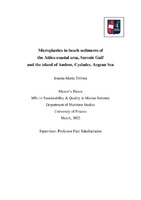Microplastics in beach sediments of the Attica coastal area, Saronic Gulf and the island of Andros, Cyclades, Aegean Sea

Master Thesis
Συγγραφέας
Τρίφωνα, Ιωάννα - Μαρία
Trifona, Ioanna - Maria
Ημερομηνία
2022-03Επιβλέπων
Σακελλαριάδου, ΦανήSakellariadou, Fani
Προβολή/
Λέξεις κλειδιά
Microplastics ; Coastal environment ; Beach sediment ; Microplastic pollution ; Attica ; Andros ; FT-IR analysis ; Plastics ; Coastal pollutionΠερίληψη
The present study is an assessment of microplastic pollution in beach sediments from the Attica
coastal area, Saronic Gulf and the island of Andros, Cyclades. Sediment sampling was
performed at the high tide line of selected stations during the summer of 2021. In total, twenty five sediment samples from Attica and five samples from Andros Island were collected and
examined. The presence of large microplastic particles (1-5 mm) was investigated. Their
abundance varied, ranging from 0 to 8 items per 5 grams of dry sediment. Higher
concentrations were noticed on Voula, Agios Kosmas and Faliro – Naftikos Omilos beaches in
Attica, and on Gialia beach in the island of Andros. The possible relation between granulometry
and microplastic distribution was also examined, with greater microplastic concentration found
in coarser sediments. Moreover, the morphology of detected microplastics was recorded;
fragments, fibers, foams and films consisted the observed microplastic shapes. The fragment
type was dominant in samples from Attica, while fibers were more numerous in samples from
Andros Island. Regarding the color, black/grey, blue, green, purple, red, white/yellow,
transparent and colorful microplastics were noticed. Green and blue particles were more
common. Additionally, the polymer composition of selected microplastics was investigated
using FT-IR analysis, which revealed the probable presence of five polymers: Polystyrene,
Polypropylene, Low-Density Polyethylene, Polyvinyl Chloride and Ethylene-Vinyl Acetate.
The results of FT-IR analysis showed that Polystyrene is possibly the dominant identified
polymer. The probable origin of microplastic presence in the studying areas was also discussed.
Samples from the Saronic Gulf presented greater occurrence of microplastics, perhaps due to
Attica’s high population and to the proximity to major urban sources.


